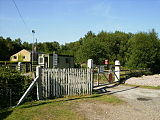Strensall
| Strensall | |
| Yorkshire North Riding | |
|---|---|
 York Road, Strensall | |
| Location | |
| Grid reference: | SE633608 |
| Location: | 54°2’24"N, 1°2’4"W |
| Data | |
| Population: | 6,047 (2011) |
| Post town: | York |
| Postcode: | YO32 |
| Dialling code: | 01904 |
| Local Government | |
| Council: | York |
| Parliamentary constituency: |
York Outer |
Strensall is a village in the North Riding of Yorkshire, on the River Foss just north of York and north-east of Haxby. The parish covers an area of 2,908 acres.[1]
The nearby Strensall Common is a Special Area of Conservation, an example of lowland heathland habitat. The southern part is designated as a Site of Special Scientific Interest. Strensall also has an army firing range and training area both of which belong to the Ministry of Defence.
History
Strensall is referred to in the Domesday Book of 1086 as Streonaeshalch, after Streona, a personal name, and halch, a corner of land. The name has altered through the centuries from Strenshale in the 11th century, to Stranessale in the 14th century and to Strencile or Strencham alias Trencham in the 17th century.[1] The name 'Streonaeshalh' was also the name of Whitby before the Viking Age.

The manor belonged to the Archbishops of York since before 1214, apart from a short period in 1547 when it was briefly held by the Duke of Somerset and Lord Wharton. During the reign of Edward the Confessor the manor and land belonged to a couple of Saxon lords known as Sasford and Turchil.[1]
The Hall with its moat and large grounds were to the north of the church. On the same site probably stood the manor-house of 1649 and 1757 which also had a moat.[1]
To the south of the village lies Strensall Camp, formed by the War Office in 1884 for training troops and now known as Queen Elizabeth Barracks.[2]
Churches
A Wesleyan chapel existing in Strensall from 1823 was succeeded by a new building in 1895. Between 1879 and 1889 a Primitive Methodist chapel was built in the village.[1]
The Parish Church of Strensall is St Mary the Virgin. The current building was consecrated by the Archbishop of York in 1866 after the old building, originally dedicated to St James, was destroyed about 1798 or 1800. There are also the Methodist Chapel and St Wilfred's Garrison Church.[1]
Strensall Common

Strensall Common lies to the east of the village and forms part of the surrounding lowland heath. There are a number of different habitats, such as wet heath, dry heath and birch/oak woodland with areas of standing water. There are over 150 plant species including, marsh cinquefoil, marsh gentian, round-leaved sundew and petty whin.
There are over 60 species of bird including curlew, whinchat, and both green and great spotted woodpecker. Amongst the numerous insects to be found are green and purple hairstreaks, the dark-bordered beauty, bog bush cricket and glowworm. Other wildlife seen here include red fox, hare and harvest mouse. Hebridean sheep and Highland cattle graze during summer to keep down vegetation.
The site is maintained by the Yorkshire Wildlife Trust.[3]
Economy

In the 19th century employment was found in a tannery in the village. There were also the Strensall Pottery and Britannia Pottery near the village.[1] Though there is some employment at the local Barracks, the village is mostly a dormitory for commuters to nearby York.
-
The Six Bells
-
The Half Moon
-
The Ship
Sport
Strensall is the home of the York Golf Club.[4]
- Football: Strensall Football Club
Pictures
| ("Wikimedia Commons" has material about Strensall) |
References
- ↑ 1.0 1.1 1.2 1.3 1.4 1.5 1.6 A History of the County of York: North Riding - Volume 2 pp @: Parishes: Strensall (Victoria County History) [1]
- ↑ "Military Camp established". http://www.yorkshirepost.co.uk/news/Walkers-dice-with-death-on.3028509.jp. Retrieved 17 December 2010.
- ↑ "Strensall Common". http://www.ywt.org.uk/nature_reserves.php?id=55.
- ↑ "Golf Club". http://www.yorkgolfclub.co.uk/pages.php/contact_us.html. Retrieved 17 December 2010.





